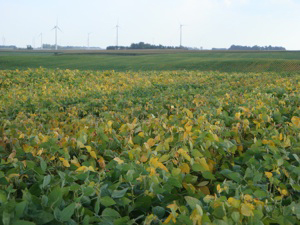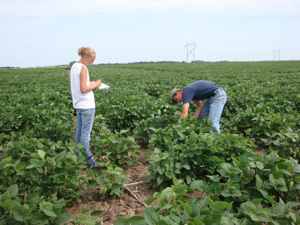Selection
Selection among lines in a soybean breeding program is analogous to the competition on the FOX network television program “American Idol”. In “American Idol”, in the initial round of competition, a large number of contestants individually sing for a few seconds before judges. This brief initial audition allows the judges to quickly and easily identify and reject many of the contestants who simply cannot sing well. These contestants are sent home. Contestants who pass this initial audition are brought back for a second, more extensive audition. Each successive round of auditions becomes more intensive and discriminating, with more contestants being sent home following each round. In the most advanced rounds of competition, contestants are required to sing different styles of music to see how versatile they are as performers. Finally after several rounds of competition, a winner is determined.
 Selection among lines in a soybean breeding program works the same way. In the Galena Genetics program, thousands of F3:4 lines are planted in unreplicated 5-foot rows at one location. Many hours are spent in the field observing and evaluating these rows for maturity, lodging, and other traits during the growing season. Tissue samples from each row may also be analyzed for molecular genetic markers. At maturity each row is harvested, and yield is determined. Furthermore, protein and oil content and other seed characteristics of the F3:5 seed harvested from these rows is determined. Based on the data obtained from this preliminary test, 90% or more of these lines will be rejected and “sent home”.
Selection among lines in a soybean breeding program works the same way. In the Galena Genetics program, thousands of F3:4 lines are planted in unreplicated 5-foot rows at one location. Many hours are spent in the field observing and evaluating these rows for maturity, lodging, and other traits during the growing season. Tissue samples from each row may also be analyzed for molecular genetic markers. At maturity each row is harvested, and yield is determined. Furthermore, protein and oil content and other seed characteristics of the F3:5 seed harvested from these rows is determined. Based on the data obtained from this preliminary test, 90% or more of these lines will be rejected and “sent home”.
The F3:5 lines remaining are put into experiments for replicated testing at three locations the following year, where the same processes of observation and yield testing are conducted. These experiments consist of 2-row plots 15 feet long. Selections from this round of replicated testing are put into experiments grown the following year at four locations for a second year of replicated testing. Subsequent years of advanced testing are conducted at many locations across the proper maturity zones in the Midwest USA, which expose the elite selections to a wide range of environmental conditions, disease factors, insects, and stresses. Galena Genetics conducts testing at 30 – 40 locations each year. As a result, each additional year of testing becomes more discriminating among an ever decreasing number of candidate lines. Selection across this wide range of environments over multiple years provides the basis for confidence in future performance of the commercial lines developed, as well as knowledge about the types of conditions in which the elite lines are best adapted.
Growing soybean yield trials requires a lot of time, resources, and specialized equipment in order to measure and capture the data necessary to make selections. Seed is packaged, with the use of electronic seed counters, into many thousands of small envelopes during late winter and early spring in preparation for planting. Trial maps must be made, and the packaged seed must be put into exact planting order and boxed according to these maps before it ever goes to the field. A customized small-plot planter is used to plant the trials in precise order according to the map.
 This planter is capable of planting plots back-to-back without stopping and without contamination from plot to plot as it continues down the field. In a good day, up to 10,000 individual plots can be planted with one planter.
This planter is capable of planting plots back-to-back without stopping and without contamination from plot to plot as it continues down the field. In a good day, up to 10,000 individual plots can be planted with one planter.
During the summer, plots are observed at every location for various characteristics. Some of the more important ones are final plant population, lodging scores, maturity date, flowering date, resistance to various diseases or pests, tolerance to iron deficiency, and plant height. At maturity, harvest is done with customized small-plot harvesters. These combines are designed specifically for small seed samples of 1 to 10 pounds. They are equipped with an electronic scale and moisture tester used to obtain accurate yield measurements from each plot. The data from these devices is automatically stored in an onboard computer. These combines are also equipped to collect and bag either a portion of seed or all the seed from each plot.
Following harvest, seed samples from each plot are analyzed in the lab for seed size using an electronic bench scale, and for protein and oil content using a near infrared spectrophotometer. Selected samples are also evaluated in the lab for water-absorption ability and other food processing characteristics.Efficient database management and analysis software is used to handle this vast array of raw data, collected throughout the year, and transform it into intelligent information. This information is then used to complete the selection process and produce a list of lines to go into the next stage of testing and selection the following year.
